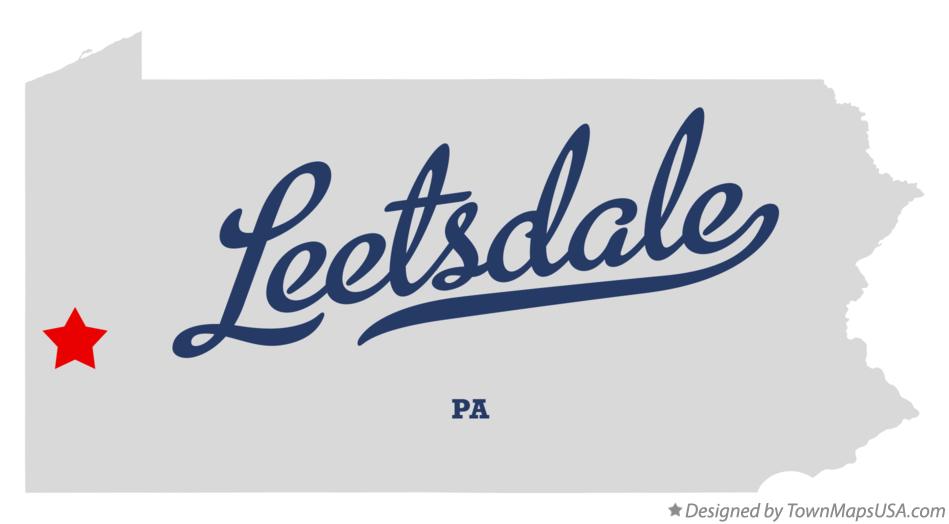
627 Beaver Road, Edgeworth – The former Wasco residence, now owned by Sewickley Academy. Originally the “Blacksmith’s House”, c. 1823 – zillow.com
I am very familiar with the red brick house along Beaver Road at Village Drive, at the Leetsdale / Edgeworth border. Like many older homes in our area, I have driven/walked/bicycled past it innumerable times over my life, and like many people I hadn’t given it a second thought until the last few years.
At the same time, I was also aware that the house was admired by many who knew about such things, and/or knew the owners and their level of commitment.

Interior of main level, library / study – Click to enlarge. – zillow.com
Leslie and I met Barbara Wasco, who owned the house with her husband Frank, at a Historical Society gathering several years ago.
After Mr. Wasco passed away in 2020 and the house was listed for sale last autumn, I started to pay a little more attention to what I already knew and liked about the site, in hope that whoever purchased the property would show the same kind of care and respect for it that Mr. and Mrs. Wasco did.
Admittedly, the news in April that Sewickley Academy had purchased the house and its one acre lot did not lend itself to encouraging thoughts, despite the reported assurances that there was “no timeline for making any plans about its use.”

Interior of sun room. Click to enlarge – zillow.com
Three additional references also contributed to this trepidation – not only from the perspective of the future, but also of the past. These references comprise the response of SA Buildings and Grounds Director Jim Miller to the media coverage of the sale.
I was also referred to this response by SA spokesperson Jennifer Donovan after requesting additional comment.
Quoting the Sewickley Herald –
‘With the scarcity of available land in Sewickley, when a property opened up so close to our athletic fields, we felt we needed to make an offer’, (Mr. Miller) said. ‘We are working with the municipality and look forward to figuring out, with their help, what the best options are for use of the property. Depending on zoning and other regulations, we’d really like to find a way for this space to benefit the whole community.’”
Before we dive any further into this rabbit hole of history, some additional perspective is necessary. Fortunately, the Sewickley Valley Historical Society’s Architecture Committee felt compelled to provide some, in the form of a letter to the Chair and Vice Chair of the SA Board of Trustees and published on the SVHS website. An edited form of the letter was published online in the Herald on May 6, and in the May 12 print edition.
The committee makes it clear that it “endorses the preservation” of both the Wasco property and a house adjacent to Nichols Field that the Academy has owned since 1994, which until last summer’s housecleaning served as the Head of School’s residence. These homes were part of the Daniel Leet / David and Eliza Leet Shields estate ‘Newington‘, and are respectively known as the “Blacksmith’s House” and the “Miller’s House”.
The document is a comprehensive accounting of the historic significance of this part of “Sewickley Bottom” (as Edgeworth was known at the time) as a “bustling rural enterprise” that has impacts across the history of the Sewickley Valley.

Aerial perspective of the buildings associated with the Leet / Shields estate ‘Newington’, along with present day land uses. Click to enlarge – Allegheny County GIS / John Linko
Along with this area’s 19th Century significance in the “story of a developing transportation network”, the Blacksmith’s House property also factored in the history of mass transportation via the Beaver Valley Traction Company, which ran a network of streetcar lines from around 1908 until 1930. According to the Ellwood City Ledger –
In late 1908…Following a merger of two Ambridge streetcar interests, Beaver Valley Traction bought out the rights to the combined route. This move required the extension of the existing Traction Co. line…to Baden. From there, it hooked up with the former French Point Electric Street Railway line, following Duss Avenue to Ambridge. The line was then extended to Edgeworth via Beaver Street. This extension became known as the Pittsburgh & Beaver Street Railway.
The Pittsburgh system…was completed to the new Sewickley Bridge round-about in 1911. This left a small, 1-mile gap between the Beaver Valley Traction and Pittsburgh systems. Unfortunately, for a multitude of political reasons, this gap was never filled. Buses would operate between the lines during the period of 1915 to 1930, but no direct streetcar service ever existed.

Early 20th Century trolley turnaround, present day – zillow.com
Because Edgeworth and Sewickley would not permit streetcars through their boroughs, the Beaver Valley Traction cars used the Blacksmith’s House property for a turnaround loop. According to Amanda Schaffer of SVHS, Edgeworth only permitted this because at that time the house had a Leetsdale mailing address. The looped driveway, pictured at right from overhead, still exists today.
Contacted in mid-May, SVHS Board Chairman Joseph Zemba stated that the Herald op-ed was “an attempt to open a community dialogue“, as he had it on good authority from Edgeworth officials also involved in SVHS that “the best way to preserve the house is civic involvement by residents“.
This admonishment is consistent with the message delivered by Edgeworth Borough since historic preservation became a topic of controversy. This began in earnest in the early 1990s, with the formation of the group Edgeworth Preservation and their efforts to enact a historic preservation ordinance – efforts which have thus far proved futile. I have written about this previously.
This is where our journey of connections begins.
If I break down Mr. Miller’s statement above by each sentence, additional information begins to come to light. With additional research and the contributions of others, connections begin to appear – some recent, some not so much – that have been forgotten, if only temporarily.
“With the scarcity of available land in Sewickley, when a property opened up so close to our athletic fields, we felt we needed to make an offer.”
One of the primary forces behind Edgeworth Preservation was Mrs. Cynthia Giles, who along with her husband Dr. Harlan Giles owned the William Walker estate “Muottas” off of Little Sewickley Creek Road. The Gileses received an award from SVHS in 1994 for their meticulous restoration of the estate and grounds.
Stymied in their attempts to get a preservation ordinance passed in Edgeworth, Mrs. Giles and others focused their efforts on documenting the history and design features of many of these estates. These efforts culminated in the publication of a book that garnered popularity locally and received several awards. Mrs. Giles was recognized as the Herald Woman of the Year for 1996.
Fast forward to late 2015, when Three Rivers Trust, representing Edgeworth billionaire Thomas Tull, purchased “Muottas” for $5.5 Million, without any preservation easement. I’ve recounted previously the history of Mr. Tull’s stewardship of the house and adjacent properties prior to his selling the whole thing to the Quaker Valley School District in 2018.
This is the same Thomas Tull whose foundation recently awarded $20 Million to Sewickley Academy, for support of multiple projects including “overhauling the school’s athletic facilities”.
The same Thomas Tull who, after selling the property that includes “Muottas”, purchased a nearly 15,000 square-foot mansion on Woodland Road, built in 2007, from Glen Meakem and his wife Diane.
This is the same Glen Meakem who twenty years ago demolished the pre-Civil War Thomas Leet Shields mansion and adjacent properties to build the new estate.
The same Glen Meakem that is currently a member of the Sewickley Academy Board of Trustees.
“We are working with the municipality and look forward to figuring out, with their help, what the best options are for use of the property”.
The Blacksmith’s House property was purchased by Mr. and Mrs. Wasco from Edgeworth Borough in 1965. The Borough had purchased it in 1962. According to the recorded deed, the property as purchased by the Borough totaled 2.5 acres.
The property sold to the Wascos was just under 1 acre of land – Edgeworth had subdivided the lot, with the remaining 1.5 acres incorporated into the adjacent Morrow-Pontefract Park.
Per the Borough website, the park was “established…in 1956 after its ten acres were donated to the Borough by the heirs of Elizabeth W. Pontefract, John D.A. and Jessie L. Morrow, and William Walker”.
This is the same William Walker who in 1904 along with his wife Jane commissioned “Muottas” from Pittsburgh architects Alden & Harlow, and 30 years later donated 81 acres of land along Little Sewickley Creek in Leet Township to Edgeworth Borough – what we know today as Walker Park.
The county historical deed card shows how “Morrow Park” was cobbled together from a total of 7 separate parcels of land, beginning in 1945 and culminating with the Blacksmith’s House parcel in 1962.
The timing and location of this activity leads me to surmise that Edgeworth’s leaders at that time saw the burgeoning development at their northwest doorstep, in the form of the Buncher Industrial District just across the border in Leetsdale. “Buncher” began operations in 1954.
It would then follow that the 1962 addition of the Blacksmith’s House acreage may have been in response to the construction of Quaker Village Shopping Center, which opened in 1963, and of Village Drive, which connected the shopping complex to Beaver Road.
Those 1.5 acres may have been envisioned as an additional buffer of green space, and if that was the case history has certainly proven this out. Amid all of the bustle that surrounds it, Morrow Park carries with it an unexpected sense of peace and renewal. It remains one of my favorite parks anywhere.

Aerial view of the immediate area of the Blacksmith’s House property, including present day land uses and municipal boundaries. Click to enlarge – Google Maps / John Linko
Not to leave a measure of preparedness unaddressed, Edgeworth and its solicitor put additional protections in place when they sold the Blacksmith’s House to Mr. and Mrs. Wasco. This took the form of a covenant within the language of the deed, stipulating that –
…the premises shall be used and occupied for single family residence purposes only and for no other purposes whatsoever, this covenant to run with the land and to be evidenced by the acceptance and recording of this indenture.
To run with the land refers to a covenant “that will exist regardless of the transference of the land. The subsequent landowner will continue being burdened or benefited by the covenant.”
The Wascos included this covenant when conveying the property to a living trust in 2007, but the deed conveying the property to Sewickley Academy does not include the covenant language above. Unless additional action has been taken, it may still be in force – at least two sources have told me that these covenants typically require a court order to be modified or removed.
The potential impact of this on any development plans is therefore unknown.
“Depending on zoning and other regulations, we’d really like to find a way for this space to benefit the whole community.”
Seemingly emboldened by their enhanced financial condition, SA has indeed wasted no time in pursuing improvements to its athletic facilities. The agenda for the May 11 meeting of Edgeworth’s Planning Commission included a “Pre–Application Conference with Sewickley Academy Regarding Nichols Field“.
In a letter to the editor published on the Herald website on May 26 and in print on June 2, former SVHS Executive Director and SA alumnus John Poister asserts that the “preliminary plans call for the demolition of the historic houses on both properties“.
Like the Architecture Committee letter before it, Mr. Poister’s letter is an eloquent defense of historic preservation, with the added advocacy of creative repurposing for these historic properties – much like the successful effort to save the “Pink House” in Sewickley, 10 years ago last month.
More recently, the Pittsburgh History and Landmarks Foundation has also made a written inquiry of the Academy’s plans, in response to feedback from “a number of concerned individuals“.
There is additional relevant history involving the Academy, Edgeworth, athletic fields, and zoning that may contribute to both community reaction and municipal deliberation.
In July 2005, the Herald reported on SA’s purchase of two residential properties and acreage along Woodland Road Extension, also in Edgeworth. County property records show that the Academy paid a little over $1.4 Million for the two parcels, which totaled around 6.5 acres.
One of the homeowners who sold their property to the Academy was Edward Abbott, who the following year purchased a house in the steep slope area of Sewickley Borough. This is the same Edward Abbott who in 2013 began flipping houses in that neighborhood, creating some development and zoning issues of his own before passing in 2018.

Aerial view of properties on Woodland Road Extension in Edgeworth that were purchased by Sewickley Academy in 2005 for the purpose of constructing athletic fields. After failing to gain borough and public approval for the project in 2006, the Academy abandoned their efforts and sold the properties. – Google Maps
Coincidental to the most recent purchase, then-Head of School Kolia O’Connor also told the Herald that “we have no immediate plans to use the properties“. It took a year to bring a proposal for large athletic fields, a pavilion, and parking to the public and the Borough – once they did, a clear picture emerged of the challenges associated with turning this pastoral setting into an athletic complex.
The first of several Herald stories outlined objections brought by nearby residents with regard to safety and esthetics. Additionally, a neighboring property owner cited covenants reached with the prior owners, requiring that their properties remain residential.
Subsequent Herald coverage reported significant disagreement, disapproval, and downright acrimony toward the proposal – adjectives quoted by the Herald included “horrendous” and “arrogant“. The Planning Commission voted down the proposal, citing incompatibility with established zoning.
The project was also determined to be within the 100-year floodplain for Little Sewickley Creek, which was reported to be ineligible for development lest borough residents lose their ability to obtain flood insurance.
After several revisions were made to the proposed facility, SA again approached the borough in October 2006. The Planning Commission again rejected the plan, which led the Academy to withdraw the plan from further consideration the following month.
SA sold the properties in 2011 and 2016.
Will History Repeat Itself?
According to Edgeworth Borough Manager John Schwend, draft plans were presented to the Planning Commission last month, but none were submitted for formal review. Mr. Schwend also stated the earliest that SA could submit plans for consideration would be for the July 13 Planning Commission meeting.
Some of the same restrictions and concerns involving the Woodland Road Extension properties appear to involve both the Blacksmith’s and Miller’s houses as well –
Zoning – The current Edgeworth zoning map shows both properties within the R-1 zone, described as low-density residential.
According to the zoning ordinance, the listed permitted and conditional uses and allowed special exceptions may not fit what is proposed.
Such factors include a minimum lot size for development – at just under one acre, the Blacksmith’s House property does not meet this minimum size requirement (60,000 square feet). This does not apply to the Miller’s House, whose lot was consolidated into the Nichols Field parcel several years ago.
Other restrictions include limits on how much of a lot may be surfaced with impervious material such as asphalt. In the R-1 zone this is limited to 15 percent of the lot size.
Floodplain – The zoning map includes an overlay indicating those areas of the borough that are in the Floodplain Hazard Overlay District. This includes approximately half of the Blacksmith’s House lot and the bulk of the Miller’s House / Nichols Field Lot.
The zoning ordinance provides very clear and informative direction on how these floodplain areas must be managed, including the following language –
2. Within any floodway area, no new construction or development shall be allowed, unless the appropriate permit is obtained from the Department of Environmental Protection Regional Office.
Covenants and Design – Aside from the aforementioned covenant in the deed for the Blacksmith’s House, the Borough appears to have doubled down in their desire to keep that property as single family housing, by making the minimum lot size for development larger than the lot they created.
Demolition – In the absence of a preservation ordinance or community activism, is it really possible that SA could just obtain demolition permits and bulldoze both houses? Per Mr. Schwend, the answer is yes. “A property owner has the right to tear down what they’ve bought” – and that’s not just true for Edgeworth, but anywhere else that doesn’t have codified protections in place – like those that protect Edgeworth’s shade trees.
Community Involvement – Given Edgeworth’s wealth of unprotected historic architecture, the borough’s elected leadership has held over the years that they would consider a protection ordinance if a sufficient number of borough residents stepped forward and requested it. The recent statement about “civic involvement by residents” would appear to echo the same sentiment.
Considering the previous failures to accomplish this, I’m wondering what portion of Edgeworth’s 1,669 residents would be sufficient for such an exploration, and in what form that interest is expected to take – packing Council chambers? Statements across traditional and/or social media? A slate of pro-preservation candidates for the next election?
Regardless of the form it takes, I’m hopeful that those citizens so inclined will oblige Council’s desire to hear from them.

John Way House, Beaver Road, Edgeworth. The original section built 1810, noted as the first brick house between Pittsburgh and Beaver. Also operated as an inn and tavern. In 1838, John Champ and William Nevin opened a school for boys here – the first location of Sewickley Academy. – Google Maps
Conclusions
According to Mr. Zemba, SVHS “is not a preservation society“, but their letter sent to SA and the Herald makes a case for preservation, while encouraging all stakeholders to adopt with them “a broader view of the community and this very historic neighborhood through the lens of education, balancing our shared history with meaningful and sensitive change.”
This appears to be a well-articulated, thoughtful approach – one that these stakeholders will hopefully feel comfortable participating in. This includes the owners of Newington, the seventh generation of the same family living there, who have reportedly commissioned a book about the Leet and Shields families and their storied estate.

SVHS marker commemorating Captain Fred Way, Ohio River Blvd. near Walnut Street, Sewickley – Mike Wintermantel, The Historical Marker Database
Perhaps they would be willing to work with SVHS and others to commemorate this legacy in a way that will not only edify but educate the community at large, i.e. a marker of some type. “Historic architecture and the cultural landscape reveal countless stories of our predecessors for future generations“.
It’s quite possible that SA is pursuing a similar strategy to what they did in 2006 – they have the financial resources to procure properties that may fit their needs, as well as develop those properties if permitted to do so.
It just seems as if that procurement process doesn’t take into account the numerous regulatory hurdles and potential community backlash that may accompany their choices. In any event, it’s prudent for the Academy to tread carefully – they’ve had quite the year already.
Summer is nearly upon us. It’s a good time to get outside and explore not only the natural beauty that exists, but also to appreciate those places built by our not-so-recent ancestors that complement their setting, and enhance the character of our community.
Maybe you passed a few on the way home today. There are plenty of ways to learn about them, supported by many of your fellow community members. Check them out – the more we learn about our past, the better prepared we are to navigate the future.
Acknowledgments
Allegheny County Office of Real Estate – Online Records Search
Sewickley Herald Digital Archive
Sewickley Valley Historical Society – Teresa Duff, Amanda Schaffer, Joe Zemba







































LOVED IT!
>
Pingback: Sewickley Academy – Securing the Future, Calculating the Past | John Linko
Pingback: Post-Election, Pre-Holiday Observations and Other Things | John Linko
Pingback: October Shorts – Books, Babies, Backpedaling, and Basketball | John Linko